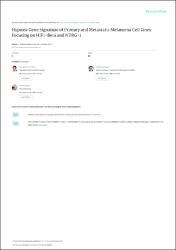| dc.contributor.author | Ercin, Mustafa Emre | |
| dc.contributor.author | Bozdoğan, Önder | |
| dc.contributor.author | Çavuşoğlu, Tarık | |
| dc.contributor.author | Bozdoğan, Nazan | |
| dc.contributor.author | Atasoy, Pınar | |
| dc.contributor.author | Koçak, Mukadder | |
| dc.date.accessioned | 2021-01-14T18:16:49Z | |
| dc.date.available | 2021-01-14T18:16:49Z | |
| dc.date.issued | 2020 | |
| dc.identifier.citation | Ercin, M. E., Bozdoğan, Ö., Çavuşoğlu, T., Bozdoğan, N., Atasoy, P., Koçak, M. (2020). Hypoxic Gene Signature of Primary and Metastatic Melanoma Cell Lines: Focusing on HIF-1β and NDRG-1. Balkan Medical Journal, 37(1), 15 – 23. | en_US |
| dc.identifier.issn | 2146-3123 | |
| dc.identifier.issn | 2146-3131 | |
| dc.identifier.uri | https://doi.org/10.4274/balkanmedj.galenos.2019.2019.3.145 | |
| dc.identifier.uri | https://app.trdizin.gov.tr/makale/TXpnek5USTBOQT09 | |
| dc.identifier.uri | https://hdl.handle.net/20.500.12587/13359 | |
| dc.description.abstract | Background: Hypoxia is an important microenvironmental factor significantly affecting tumor proliferation and progression. The importance of hypoxia is, however, not well known in oncogenesis of malignant melanoma. Aims: To evaluate the difference of hypoxic gene expression signatures in primary melanoma cell lines and metastatic melanoma cell lines and to find the expression changes of hypoxia-related genes in primary melanoma cell lines at experimental hypoxic conditions Study Design: Cell study. Methods: The mRNA expression levels of hypoxia-related genes in primary melanoma cell lines and metastatic melanoma cell lines and at experimental hypoxic conditions in primary melanoma cell lines were evaluated by using real-time polymerase chain reaction. Depending on the experimental data, we focused on two genes/proteins, the hypoxia-inducible factor-1 beta and the N-myc downstream regulated gene-1. The expression levels of the two proteins were investigated by immunohistochemistry methods in 16 primary and metastatic melanomas, 10 intradermal nevi, and a commercial tissue array comprised of 208 cores including 192 primary and metastatic malignant melanomas. Results: The real-time polymerase chain reaction study showed that hypoxic gene expression signature was different between metastatic melanoma cell lines and primary melanoma cell lines. Hypoxic experimental conditions significantly affected the hypoxic gene expression signature. In immunohistochemical study, N-myc downstream regulated gene-1 expression was found to be lower in primary cutaneous melanoma compared to in intradermal nevi (p=0.001). In contrast, the cytoplasmic expression of hypoxiainducible factor-1 beta was higher in primary cutaneous melanoma than in intradermal nevi (p=0.001). We also detected medium/strong significant correlations between the two proteins studied in the study groups. Conclusion: Hypoxic response consists of closely related proteins in more complex pathways. These findings will shed light on hypoxic processes in melanoma and unlock a Pandora’s box for development of new therapeutic strategies. | en_US |
| dc.language.iso | eng | en_US |
| dc.relation.isversionof | 10.4274/balkanmedj.galenos.2019.2019.3.145 | en_US |
| dc.rights | info:eu-repo/semantics/openAccess | en_US |
| dc.title | Hypoxic Gene Signature of Primary and Metastatic Melanoma Cell Lines: Focusing on HIF-1? and NDRG-1 | en_US |
| dc.type | article | en_US |
| dc.identifier.volume | 37 | en_US |
| dc.identifier.issue | 1 | en_US |
| dc.identifier.startpage | 15 | en_US |
| dc.identifier.endpage | 23 | en_US |
| dc.relation.journal | Balkan Medical Journal | en_US |
| dc.relation.publicationcategory | Makale - Ulusal Hakemli Dergi - Kurum Öğretim Elemanı | en_US |
















